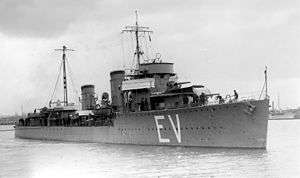Admiralen-class destroyer
The Admiralen class were eight destroyers built for the Royal Netherlands Navy between 1926 and 1931. All ships fought in World War II and were scuttled or sunk.
 HNLMS Evertsen | |
| Class overview | |
|---|---|
| Name: | Admiralen class |
| Operators: |
|
| Preceded by: | Wolf class |
| Succeeded by: | Gerard Callenburgh class |
| Built: | 1926–1930 |
| In commission: | 1928–1942 |
| Completed: | 8 |
| Lost: | 8 |
| General characteristics | |
| Type: | Destroyer |
| Displacement: |
|
| Length: | 98 m (321 ft 6 in) |
| Beam: | 9.53 m (31 ft 3 in) |
| Draught: | 2.97 m (9 ft 9 in) |
| Propulsion: |
|
| Speed: | 36 kn (67 km/h) |
| Range: | 3,200 nmi (5,900 km) at 15 kn (28 km/h) |
| Complement: | 129 (120 in second group) |
| Aircraft carried: | 1 × Van Berkel W-A |
| General characteristics First group | |
| Armament: |
|
| General characteristics Second group | |
| Armament: |
|
_2.jpg)
Design
These ships were built in the Netherlands with assistance from the British company Yarrow (at that time the leading builder of destroyers in the world). The Dutch ships were based on the British destroyer HMS Ambuscade. A novel feature was the provision of a seaplane for scouting. There was however no catapult, the plane being lowered into the sea by a crane.
The differences between the two groups were minor; the second group was fitted for minesweeping rather than mine laying, and they carried one less 75-millimetre (3 in) gun for 30 tons of fuel.[1]
Design
Between 1925 and 1928 eight new destroyers were laid down to replace the Wolf-class destroyers. The design came from Yarrow & Co, they based it on HMS Ambuscade and HMS Amazon. The Royal Netherlands Navy took the Yarrow & Co design and made some minor changes.
The first group was fitted with four 120mm no. 4 Bofors guns, while the second group was fitted with four 120mm no. 5 HIH Siderius guns. The main differences are the mounts used and the no. 4 were able to elevate between −5 and +30 degrees while the no. 5 guns could elevate between −5 and +35 degrees, giving a range of 19,500 meters.[2]
The second group was equipped with 40mm no. 1 Vickers AA guns, however these guns had problems firing at higher angles; the guns would malfunction or not fire at all. Because of this the ships of this group could use only their single 75mm AA gun against targets above 1000 meters. After 12 years of ignoring this issue it was finally solved in 1939 by stiffening the guns, however when Germany invaded the Netherlands started in May 1940 this issue wasn't solved for the surface ships of the Royal Netherlands Navy.
Ships
| Name | Laid down | Launched | Commissioned | Builder | Fate | |
|---|---|---|---|---|---|---|
| First group | ||||||
| Van Ghent ex-De Ruyter |
28 August 1925 | 23 October 1926 | 31 May 1928 | KM de Schelde | Served in the Netherlands East Indies as part of Admiral Karel Doorman's command. Ran aground and was scuttled on 15 February 1942. | |
| Evertsen | 5 August 1925 | 29 December 1926 | 12 April 1928 | Burgerhout | Served in the Far East. Sunk by the Imperial Japanese Navy on 1 March 1942. | |
| Kortenaer | 24 August 1925 | 30 June 1927 | 3 September 1928 | Burgerhout | Served in the Far East. Sunk by a torpedo from the Japanese cruiser Haguro during the Battle of the Java Sea on 27 February 1942. | |
| Piet Hein | 26 August 1925 | 2 April 1927 | 25 January 1928 | Burgerhout | Served in the Far East. Sunk by Japanese destroyers during the Battle of Badung Strait on 19 February 1942. | |
| Second group | ||||||
| Van Galen | 28 May 1927 | 28 June 1928 | 22 October 1929 | Fijenoord | Based in the Netherlands at the start of World War II, the ship was dispatched to help with the defence of Rotterdam. Targeted by German bombers in the narrow river she suffered bomb damage and sank on 10 May 1940. The wreck was salvaged and scrapped by the Germans. | |
| Witte de With | 28 May 1927 | 11 September 1928 | 20 February 1930 | Fijenoord | Scuttled on 2 March 1942 on account of damage incurred during the Battle of the Java Sea. | |
| Banckert | 15 August 1928 | 14 November 1929 | 14 November 1930 | Burgerhout | Damaged by Japanese bombers and scuttled in Surabaya dockyard. Salvaged by the Japanese, but not repaired and returned to the Dutch after the war. Sunk as a target in September 1949. | |
| Van Nes | 15 August 1928 | 20 March 1930 | 12 March 1931 | Burgerhout | Sunk after a two-hour battle by Japanese aircraft on 17 February 1942, while escorting a refugee ship (which was also sunk). | |
References
Citations
- Conway's 1922–46, p. 390.
- Visser, Jan. "12 cm Mark 4, 5, 6 and 7". netherlandsnavy.nl. Retrieved 4 July 2017.
References
- Gardiner, Robert; Chesneau, Roger, eds. (1980). Conway's All the World's Fighting Ships: 1922–1946. London: Conway Maritime Press. ISBN 0851771467. OCLC 7734153.
- Whitley, M.J. (1988). Destroyers of World War 2. Cassell Publishing. ISBN 1-85409-521-8.
- Goossens, A.M.A. (2007), Het Staatsbedrijf der Artillerie Inrichtingen, p. 9